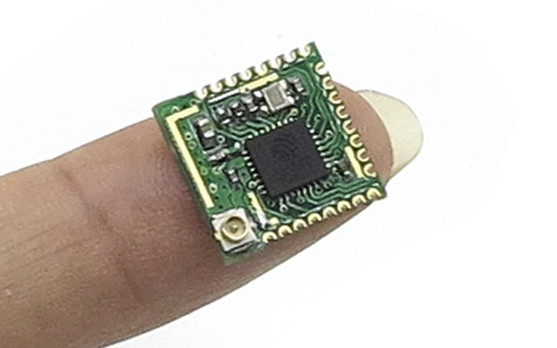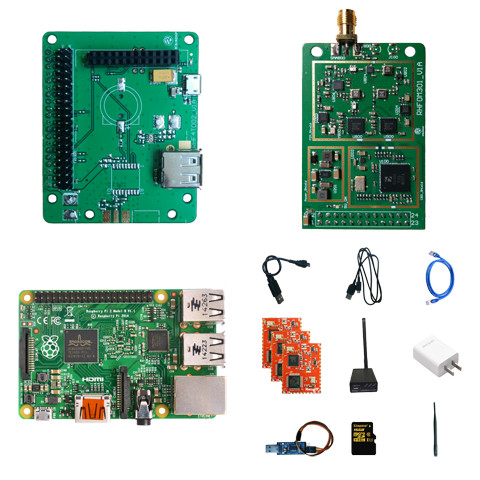NanoPi NEO is an exciting ARM Linux board due to the power it packs into its small size, and its low price starting at $7.99. It’s made by FriendlyARM, and since I’ve read some people had never heard about the company before, I’d like to point out it has been providing development boards well before the Raspberry Pi board was launched, with products such mini2440 based on a Samsung ARM9 processor introduced around year 2010. Anyway, I asked the company if they were willing to send 2 samples for review, as I plan to remove the USB & Ethernet port on one of them. Instead I got a 4 boards and accessories, so I’m going to start reviewing the board by writing a quick start guide, showing how to setup it, and check out the Ubuntu core provided by the company. If you are a fan of armbian made Debian […]
Onion Omega2 is a $5 Linux WiFi IoT Board (Crowdfunding)
Onion Omega board was first introduced in 2015. The tiny OpenWrt Linux board featured an Atheros AR9331 processor with GPIO headers, and various baseboards and add-ons. The company has now launched a Kickstarter campaign for the second versions – Omega2 & Omega2 Plus – with a faster processor @ 580 MHz, compatible with docks and add-ons boards used for Omega, and a much lower price with $5 for the Omega2, and $9 for Omega2 Plus with more storage and memory. Omega2 & Omega2 Plus specifications: WiSoC – 580 MHz processor, possibly Mediatek MT7688 MIPS processor used in LinkIt Smart 7688 System Memory Omega2 – 64MB Omega2 Plus – 128MB Storage Omage2 – 16MB flash Omega 2 Plus – 32MB flash + micro SD slot Connectivity Built-in – 802.11 b/g/n WiFi with on-board and external antenna support Via add-on boards – Bluetooth 4.0 LE, GPS, and 2G/3G Expansion – 15x GPIO, […]
PSF-A85 is a $2 ESP8285 WiFi Board for IoT and Wearables
Last month, we found out that Espressif has made a smaller version of ESP8266 targeting wearables called ESP8285, but the only development board available at the time was quite more expensive than usual at about $25. ITEAD has now released an ESP8285 module with some I/Os and an IPEX connector which they sell for just $1.99 + shipping. PSF-A85 specifications: SoC – Espressif ESP8285 Tensila WiFi SoC @ 80/160 MHz with 1MB flash Connectivity WiFi 802.11 b/g/n/d/e/i/k/r with support for STA/AP/STA+AP modes, WPA/WPA2 PSK and WEP security Antenna – IPEX connector (antenna not included) or “stamp hole interface” Expansion – 24-pin with GPIO, PWM, UART up to 460800 bps, SPI, ADC, Power Supply – 3.3 V Dimensions – 13.7 x 13.4 mm More technical information include the schematics (PDF only) and ESP8285 datasheet can be found in the Wiki, which sadly does not contain any software / getting started information, […]
Nordic Semiconductor nRF52832 Cortex-M4 ANT & Bluetooth LE SoC Gets Even Tinier
Nordic Semiconductor nRF52832 is a Bluetooth 4.2 LE SoC based on an ARM Cortex-M4F core that was first released about a year ago in a QFN48 package targeting IoT and Wearables. But if your application is really tight on space and the 6x6mm package is just too big, the company has just introduced a 3.0×3.2mm WL-CSP (Wafer Level Chip Scale Package ) package for nRF52832 decreasing the area to about one quarter of the QFN package The specifications are exactly the same as the QFN, but let’s see what we’ve got in that 9.6mm2 package: MCU Core – ARM Cortex-M4F @ 64 MHz with DSP & FPU, 512kB Flash and 64kB RAM 2.4 GHz radio for ANT, Bluetooth 4.2 LE, and Gazell connectivity; 5.5mA peak RX/TX currents; on-chip RF Balun On-chip NFC tag Peripherals – 3x Master/Slave SPI, 2x Two-wire interface (I²C), UART (RTS/CTS), 3x PWM, Digital microphone interface (PDM) Security […]
RisingHF IoT Discovery is a LoRaWAN Evaluation Kit for Raspberry Pi
There are many current and upcoming long range low power wireless protocols for the IoT, but this morning I learned that South Korea launched a LoRa network (aka LoRaWAN), after another launch in the Netherlands earlier this year. While there are also some LoRa hobbyist kits such as LoraONE and LoPy being worked on, I decided to look on Aliexpress, but only got two products were listed: a LoRaWAN temperature and humidity sensor, and a LoraWAN USB modem. Both of them are made by a company called RisingHF. Among the products offered by the company, there’s a potentially interesting development kit called RisingHF IoT Discovery with the following components: 1x Raspberry Pi board 1x RHF0M301 LoRa Gateway based on Semtech SX1301 1x RHF4T002 adapter for Raspberry Pi and RHF0M301 1x RHF3M076 LoRaWAN USB AT Modem End point to connect to computer. It operates at 434MHz, 470MHz,868MHz, and 915MHz 3x RHF76-052 […]
UL Goes Beyond Electrical Safety with UL 2900 IoT Security Standard
UL is a company providing testing and safety certifications with electrical, building, fire, mechanical and other codes to ensure products sold to consumers and companies are as safe as possible, and follow their UL standards. For example, you should probably look for the UL logo on any 100~240V electrical appliances, power supplies, etc… to make sure you purchase safe products, and also in order to avoid voiding any insurance you may have in case of fire. The company is now getting into cybersecurity, specifically for IoT security, with UL 2900 standard. The standard is currently divided into three parts: UL 2900-1 – Outline of Investigation for Software Cybersecurity for Network-Connectable Products, Part 1: General Requirements UL 2900-2-1 – Outline of Investigation for Software Cybersecurity for Network-Connectable Products, Part 2-1: Particular Requirements for Network Connectable Components of Healthcare Systems UL2900-2-2 – Outline of Investigation for Software Cybersecurity for Network-Connectable Products, Part […]
WiThumb is an ESP8266 WiFi USB Adapter with Motion and Temperature Sensors (Crowdfunding)
There are now plenty of Espressif ESP8266 boards or module to play with, but most of them require some cables or wires, at least for power. WiThumb does not need any of that as it’s designed to be plugged into any USB ports, and includes a 6-axis motion sensor, and a temperature sensor. WiThumb USB dongle specifications: SoC – Espressif ESP8266 32-bit MCU with 802.11b/g/n WiFi Storage – 4MB Flash memory Sensors – Temperature sensor (+/- 0.25C typical accuracy, -40 to 125 C range), 6-axis gyroscope + accelerometer Expansion – Breadboard friendly through holes with 1x 10-bit ADC, I2C and 4x GPIOs USB – USB type A connector Misc – Reset and flash buttons Power – 5V via USB port Dimensions – 4.8 x 2.2 cm The USB stick can be programmed like most ESP8266 board, i.e. via USB using the Arduino IDE. In case you wonder what kind of […]
$25 Ameba Arduino IoT Board Powered by Realtek RTL8195AM MCU Supports WiFi and NFC
Ameba Arduino is another development board for the Internet of Things, but beside WiFi connectivity, it also includes an NFC tag, and can support Ethernet via Arduino compatible headers. The brain of the board is Realtek RTL8195AM ARM Cortex M3 MCU that includes WiFi connectivity, hardware SSL, SRAM, and flash. Ameba Arduino Specifications: MCU – Realtek RTL8195AM ARM Cortex M3 @ up to 166MHz with 512KB SRAM, 1MB ROM, WiFi connectivity, hardware SSL engine Memory – 2MB SDRAM Connectivity – WiFi 802.11 b/g/n 1T1R with PCB antenna and external antenna connector, NFC tag with read/write Function, 10/100M Ethernet via expansion headers USB – 1x micro USB OTG port, 1x micro USB host port Expansion Headers SDIO Device/SD card controller Up to 30x GPIOs 2x SPI interfaces supporting master and slave modes 3x UART interfaces including 2 HS-UART and one log UART 4x I2C Interfaces supporting master and slave mode 2x […]










